2022 Yamaha MT-10 SP Review - First Ride

The MT-10 steps it up with some help from Öhlins.
Let the record show that, despite my best efforts, Yamaha’s MT-10 was not included in either the street or track portions of our mega seven-way open-class naked bike shootouts last year. I fought for its inclusion but was ultimately denied by the Bossman who wrote it off by saying our field was big enough and it wasn’t going to win anyway. That and we also knew a new one was already on the way.
2022 Yamaha MT-10 SP
Editor Score: 83.5%
| Engine | 18/20 | Suspension | 14/15 | Transmission | 7.5/10 |
| Brakes | 8/10 | Instruments | 4/5 | Ergonomics | 8/10 |
| Appearance | 8/10 | Desirability | 8/10 | Value | 8/10 |
+ Highs
- The quickshifter is brilliant on the street
- The crossplane sound is magnificent
- Making suspension adjustments at the push of a button really is nice
– Sighs
- The quickshifter is horrible on the track
- Initial throttle is too abrupt in one mode and not quick enough in another
- I’d like different brake pads and a reflash to open up the top end
While I agree that the MT-10 wasn’t going to win against such steep competition, I also thought it would surprise a few people with its combination of performance and price. Alas, I had to concede. But maybe its exclusion was a blessing in disguise. Since we’ll never know how the bike would have stacked up, I can play the ignorance card and say it would have done well – but not as well as Yamaha’s better version, the 2022 MT-10 that John reviewed back in August. And it really wouldn’t have done as well as the bike you see here; Yamaha’s new MT flagship – the MT-10 SP.
Of course, imagining all these hypotheticals is an exercise in futility. Instead, let’s just take a moment to appreciate the bike in front of us. Which, as it turns out, is really just an MT-10 with Öhlins electronic suspension and steel-braided brake lines. Mechanically speaking, anyway. You’ve also got a polished aluminum swingarm, a color-matched lower fairing, and an exclusive paint scheme: Liquid Metal/Raven.
And that, my friends, is it.
Simple, But Effective
It doesn’t sound like much, right? I, too, was a little shocked to discover the only real performance difference between the standard and SP models were suspension and front brake lines, but sometimes, less is more. At least, that’s what they say. Then again, let’s not discredit Öhlins electronic suspension here. In theory anyway, the idea of having six different suspension “maps” – three automatic modes and three manual modes – sure beats having to grab tools and change clickers.
For the unaware, the automatic settings are predetermined suspension parameters developed by Öhlins and Yamaha, and instead of referencing the usual terminology of compression or rebound, the automatic modes refer to levels of support – mainly acceleration support and braking support. A-1 is the firmest and meant for aggressive riding on smooth pavement, A-2 is neutral middle ground, and A-3 is the softest setting, meant for a more comfortable ride (while still being sporty; this isn’t a cruiser after all). You can also navigate to the menu screen and customize each of these settings further, in case you want to fine-tune. The manual modes revert back to the suspension terms we traditionally use, and instead of the two ends working in harmony to try and achieve the desired ride like in the automatic modes, manual modes work like analog suspension, except you can change the rebound and compression settings electronically. An important distinction to make is that spring preload is still adjusted manually at both ends.
Besides the most obvious advantage steel braided brake lines give – a firmer feel at the brake lever because the brake lines aren’t expanding – Yamaha also credits them for giving the front brake more feeling. This has been a sticking point with Yamaha for years after journo types like Yours Truly have complained in the past about Yamaha front brakes being very wooden.
To see if any of Yamaha’s claims are true, the Tuning Fork Folk invited us out to the Petersen Automotive Museum in Los Angeles, the starting point for what would be a real-world evaluation of the MT-10 SP. We’d pick our way through the city, slog on the freeway a short while, and make our way west to Pacific Coast Highway where we’d terrorize…errr…navigate our way through the Malibu hills and onto some of motorcycle journalism’s favorite canyon roads.
Upping the ante even further, and to push the MT-10 SP beyond what we could on the street, we then took the bike to Buttonwillow Raceway for a full day of shredding at the track. This would really test the electronic suspension’s abilities and see if Yamaha’s claims about the steel brake lines held any weight.
Street
Locals know it and outsiders have probably heard about it: the streets of Los Angeles are beat up and choppy with potholes abound thanks to the endless amount of traffic coming through every day. If you want a truly comfortable ride here, then you’ll have to be riding on pillows with suspension settings set to “Cadillac.” As versatile as electronic suspensions are, not even Öhlins have discovered how to achieve that setting yet and still give you a proper ride everywhere else. By default when you key on the MT-10 SP the suspension is set to A-2 mode, the middle setting.
With settings in the middle of the range across the board, riding through LA was about as firm as you’d expect from a sporty naked bike. You definitely feel the bumps, but they don’t jolt you. The suspension feels as though spring rates or compression settings were slightly on the stiffer side, as there’s not a lot of give in the suspension. Then again, sporty bikes usually lean toward slightly firmer rides on the roads. So, none of this is really surprising. And, let’s not forget, the streets around here really are that bad.
Nonetheless, I didn’t want to change the settings just yet until we got to the canyons to see how A-2 would behave on the freeway and the more open expanses of Pacific Coast Highway. Cruising along, the A-2 setting was a good middle ground. I did break my own rule momentarily to try the A-3 setting, which did soften things up a little. It worked well for the freeway stint, but once I got off the freeway I popped back into A-2 on the long, flowing portions of PCH. I had to pull over to do it, however, because the bike has to be stopped.
What was a little more annoying was the throttle response in Power Mode 2, which is also the default setting. I didn’t like the amount I had to twist the throttle before any power started being felt. Even then, the initial amount of power being delivered was too little for how much I was turning the grip. It was similar to having too much throttle play, but that wasn’t the case since these MT-10s have been ride-by-wire for some time. The simple answer would be to switch to Power Mode 1, but this produced the opposite problem – being too abrupt for normal street riding – though it did feel less twitchy than past Yamahas.
The hardest thing to manage is your own self-restraint because the crossplane crankshaft sounds so good you’re constantly finding reasons to hear it sing. Yamaha even goes so far as to pipe some of that noise out of the top of the tank vent, straight to your ear holes. Cheeky. But when the actual power delivery is either too soft or too abrupt, it can make you think twice before twisting that grip. Eventually, I left it in Power Mode 2 and adjusted to applying the throttle a touch sooner than normal to have the power actually hit when I wanted it to. The nice thing is, once you get moving along on the freeway, you can switch on the cruise control and make throttle management super easy!
It should go without saying, but without any wind protection, you’re going to feel it. It wasn’t bad for my 5-foot, 8-inch frame, but I’d probably pop for a small flyscreen for a little more wind deflection if this were my bike.
Once we got to the good roads I discovered the SP can be configured in many different ways, and a single-day ride with it couldn’t cover everything. Playing along in the hills I realized there were a lot more bumps than the last time I visited and it seemed like the A-2 suspension settings were still too stiff for my liking, with rebound that was too slow and compression that wasn’t, well, compressing. I thought a switch to A-3 was in order.
With softer overall settings, I got the desired result. However, in practical use (and with our, um, spirited pace) on these bumpy and twisty roads, I could feel the bike noticeably compress but not come up quick enough. The result felt like a sudden thud that was jarring in a different way. I made minor setting changes to try and get the ride more to my liking, but I simply ran out of time to find something I liked. Ultimately, switching back to A-2 seemed to be, yet again, the happy medium.
On the bright side, the decision to fit the SP with 190/55 tires (as opposed to 190/50 tires other manufacturers use) was a good one as the bike tips into bends much easier. I’m sure the wide handlebars help get the SP turned, but not having to fight the basically flat profile of a 50-series tire ( especially after coming off two sport-tourers with those tires) really benefits overall handling. The pointy nature of a 200-series tire would feel even better, but I digress.
Handling on the MT-10 (standard or SP) wasn’t really one of the bike’s weaknesses, and on the street anyway, it’s still not much of a problem. Much more capable hands than my own were piloting the SP at a ridiculous pace through Latigo canyon, Piuma, and Stunt Road with hardly a dab of the brakes.
Ah yes, the brakes. High-end Yamahas, the SP included, have had an interesting phenomenon where the actual braking power is high, but the feel at the lever wasn’t that great. With the SP’s steel lines in the front that trait remains. It’s just slightly different. Lever feel is more firm with the lines, there’s no doubt, but I’d still prefer more bite from the brakes themselves. I’ve really become a broken record with the line about switching to more aggressive pads, but I really think it would add a lot to the SP’s overall brake feel.
Track
If ever you want an environment to test suspension and brakes, the racetrack is it. Buttonwillow Raceway Park has a few choice bumps and plenty of braking zones, so it was a good venue to test the SP. It also happened to be the venue where Dunlop invited us to test its new Q5 and Q5S tires (look for that review in a separate story), so they spooned on both tires in the OE 190/55 sizing.
First impressions? Oddly enough, neither the suspension nor the brakes come to mind first. In the track environment, the Yamaha’s passenger pegs get in the way of placing my feet where I want them, so I’m constantly adjusting. But that’s not a big deal. The big deal is the quickshifter is completely out of its element. This was shocking considering I was enamored by it on the street ride, where it performed flawlessly. On the track, however, I had to make sure upshifts were performed while the revs were rising, not at steady throttle, and yet also not too close to redline. Even then, sometimes upshifts were a bit of a struggle.
None of that compares to the several botched downshifts from the quickshifter, though. Normally in a track setting, downshifts are done in rapid-fire succession. Several quickshifters, including factory-equipped units, are able to accommodate this request without any drama (it’s been a while, but I thought the R1 had no problems with this either). Not the SP. Downshifts need to be spaced out so the engine never hits, or gets close to, redline after a downshift. This alone rules out rapid-fire downshifts, which then occupies brain space that could be used for other things, like setting up for the corner. Not only that, but you really have to be unusually firm and deliberate with the lever each time you go for a downshift – especially if you’re going from second to first gear. Sure, you could use the clutch to change down the gears easier, but then what’s the point of the quickshifter?
Quickshifter aside, once that R1 engine is screaming, you can’t help but notice the engine falls a bit flat up top. Likely a result of emission tuning trickery, it’s easy to imagine a considerable amount of power is still on the table once those codes are cracked in the ECU, and the full potential of the engine is let out. Still, it’s a sound I couldn’t get enough of, even with the stock exhaust.
Of course, a screaming engine also means an MT-10 SP moving at a rapid pace. Buttonwillow’s last turn is a 90-degree left, preceded by a short straight. It’s a popular passing spot on the brakes and a good test for the SP’s upgraded system. Except with the SP’s ABS still in its constant setting, ABS intervention was far too sudden and early, causing me to have to brake earlier to compensate and not trigger it. The ABS2 setting is supposed to be more focused toward aggressive riding and adjusts brake pressure based on several factors including lean angle. It works, but it feels more street-oriented than track, as it would still intervene at lean angles I felt didn’t necessitate ABS intervention for the conditions (clean racetrack and sticky tires). Fortunately, it’s not anywhere near as intrusive as the ABS1 setting and could be a real benefit when the ground conditions are slippery or otherwise tricky. Say, due to rain. You can also turn ABS off if you want.
I hate to say it, but I stick with the overall impression of the brakes as I had before – the power is there, but I wish they had more bite. Or possibly a different Brembo master cylinder from the one already on it. Maybe both. I think at least one of those items will be a big step in the braking department.
On the suspension side of things, after some initial adjustments in the morning to the A-2 setting to give it a little more compliance, the electronic stuff quickly faded into the background. It was surprising how composed the SP felt around the track. Hard braking (even with ABS kicking in) was met with nice support from the fork, while hard acceleration gave just the right amount of squat without unweighting the front too much and causing the bike to run wide. If we could, we’d find a way to add even more forward pitch to get some more weight over the front. An easy solution would be to try a larger rear tire, but we wanted to see how the bike behaved with the standard sizing (which clearly means a follow-up test is in order). In the end, we did add a tiny bit of preload to the shock, but that’s it. After that, it was all about enjoying the track time. Which is how it should be.
Is It A Naked Bike Contender?
For as fun as the MT-10 SP is, I have to be realistic and admit that the bikes sitting atop the big bore naked bike mountain don’t have to worry about the MT-10 SP unseating them. The likes of the Ducati Streetfighter V4, Aprilia Tuono, and KTM 1290 Super Duke are still going to reign supreme. But I still stand by my original statement that the MT-10 deserves a seat at the table. As I write this, in November 2022, Yamaha’s price for the current model year bike is $16,899. However, in 2023 Yamaha’s raised the price to $17,199 and the bike is exactly the same. It still comes in a grand or two lower than its rivals, but there’s no denying the performance gap, at least if you’re an adrenaline junky, still favors the European bikes.
I admit I have an appreciation for the MT-10 that borders on irrational. Maybe it’s because I tend to cheer for the underdog. Yes, I recognize there are superior bikes in the category, but I think there’s a place for the MT-10 SP for riders who appreciate Japanese motorcycles as being dependable workhorses that can get the job done. And with a few tasteful, and relatively affordable, mods you can get performance rivaling its Euro counterparts.
Troy’s Street Gear
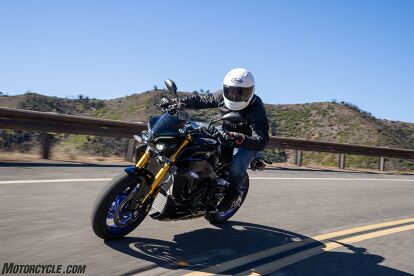
Helmet: Arai Regent-X
- Communicator: Cardo Packtalk Edge
- Jacket: Alpinestars Oscar Bomber (Discontinued)
- Airbag: Alpinestars Tech-Air 5
- Jeans: Alpinestars Diesel Shiro
- Gloves: Alpinestars SP-2 v2
Troy’s Track Gear

Helmet: LS2 Thunder Carbon
- Suit: Alpinestars GP Force Chaser
- Airbag: Alpinestars Tech-Air 5
- Gloves: Alpinestars GP Tech v2 S
Boots: Alpinestars Supertech R
2022 Yamaha MT-10 SP Specifications | |
|---|---|
| MSRP | $16,899 |
| Engine Type | 998 cc liquid-cooled inline-Four, DOHC, four valves per cylinder, 270-degree crank |
| Bore and Stroke | 79.0 x 50.9 mm |
| Compression Ratio | 12.0:1 |
| Horsepower | 163.6 hp @ 11,500 rpm (claimed crankshaft, Yamaha UK) |
| Torque | 82.6 lb-ft @ 9000 rpm (claimed crankshaft, Yamaha UK) |
| Transmission | 6-speed, up/down quickshifter, slip-assist clutch |
| Final Drive | Chain |
| Front Suspension | 43mm Öhlins electronically controlled suspension, fully adjustable; 4.7-in travel |
| Rear Suspension | Öhlins electronically controlled suspension, fully adjustable; 4.7-in travel |
| Front Brake | Dual 320mm disc, radial-mounted four-piston calipers, lean-sensitive ABS |
| Rear Brake | 220mm disc, lean-sensitive ABS |
| Front Tire | 120/70-ZR17 Bridgestone Battlax Hypersport S22 |
| Rear Tire | 190/55-ZR17 Bridgestone Battlax Hypersport S22 |
| Rake/Trail | 24 deg/4.0 in |
| Wheelbase | 55.3 in. |
| Seat Height | 32.9 in. |
| Curb Weight | 472 lbs. (claimed) |
| Fuel Capacity | 4.5 gal. |
| Colors | Liquid Metal/Raven |
| Warranty | 1-year limited warranty |
We are committed to finding, researching, and recommending the best products. We earn commissions from purchases you make using the retail links in our product reviews. Learn more about how this works.
Become a Motorcycle.com insider. Get the latest motorcycle news first by subscribing to our newsletter here.

Troy's been riding motorcycles and writing about them since 2006, getting his start at Rider Magazine. From there, he moved to Sport Rider Magazine before finally landing at Motorcycle.com in 2011. A lifelong gearhead who didn't fully immerse himself in motorcycles until his teenage years, Troy's interests have always been in technology, performance, and going fast. Naturally, racing was the perfect avenue to combine all three. Troy has been racing nearly as long as he's been riding and has competed at the AMA national level. He's also won multiple club races throughout the country, culminating in a Utah Sport Bike Association championship in 2011. He has been invited as a guest instructor for the Yamaha Champions Riding School, and when he's not out riding, he's either wrenching on bikes or watching MotoGP.
More by Troy Siahaan












































































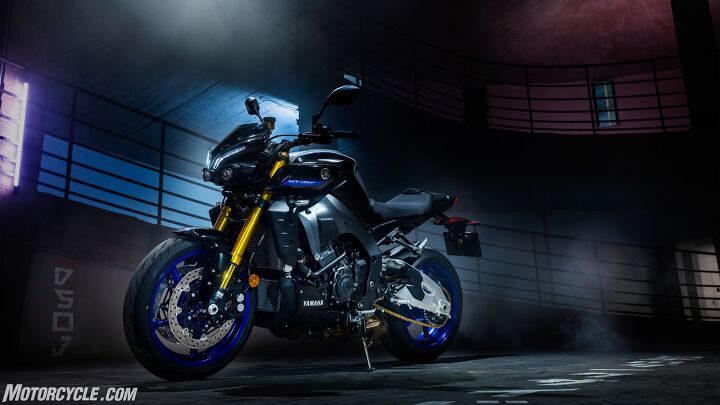






















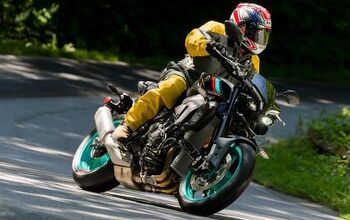
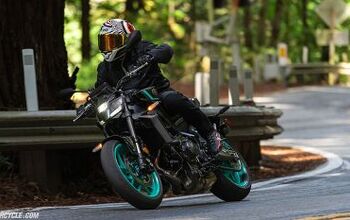




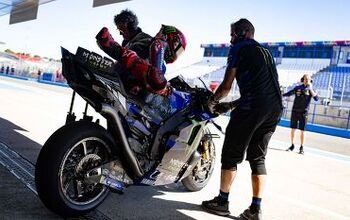







Comments
Join the conversation
The MT-10, whether in base or SP flavors, is a bike that should demand my attention and incite me to buy it, some way, some how. But it doesn't now, and never has. And for the life of me I don't know exactly why. I don't find it unlovely as some do. The performance numbers seem good enough. The things that aren't great as reported by the press all seem to be addressable in the aftermarket for way less money than you'd spend buying one of the MT's more expensive competitors to start with. But it's just ... not ... interesting. Mystery.
I wonder if I'd feel differently if Yamaha gave the MT the XSR treatment and offered us that retro-ish result to consider.
Does the Ohlins suspension feel more comfortable than the standard KYB suspension? I have the standard version and the suspsension feels very stiff.